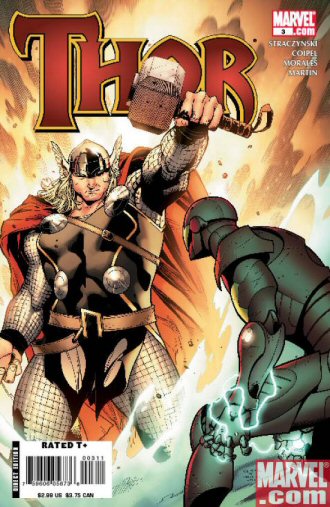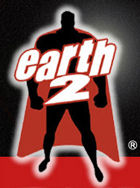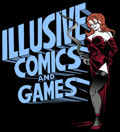writer: J. Michael Straczynski
artists: Olivier Coipel and Mark Morales
Some time ago, Straczynski tackled a national tragedy
in a black-covered superhero book "…destined to be a classic."
That was written in a time of reflexive grief, sincere and
pain-ridden, but also ridiculously maudlin. So upon opening
Thor #3 to see the Thunder God in New Orleans, it
would be understandable if you closed it and walked away.
Understandable, but wrong. After a mixed bag of a first
issue, this Thor revival has turned into a must-read,
commenting on the Marvel Universe only slightly, but in
two issues also containing more story bang for your buck
than most other Marvel books.
Stracyznski takes on three major ideas with this issue,
all of which interweave with delicate skill. Being dead
for a few years does take some adjustment, but Thor looks
around at what has become of Marvel and gets pissed.
The overall drive for this arc, and perhaps for this book,
is for Thor to restore the lost gods of Asgard. Somehow
sensing his kindred spirits - and for now, wisely, they
are spirits inhabiting mortals - Thor begins his search
in the Big Easy, which we all know has become anything but.
However, his sense of duty toward mankind outweighs his
quest as the devastation tears at his soul. How, he asks,
could responsible superbeings allow this to happen? Of course,
the answer is because they are fictional, so it's always
weird when a real-life event pokes into a comic book like
this. But another answer, which JMS provides here, makes
more sense in context - they're too busy fighting their
petty fights.
No fight to Thor could have been more petty than the Civil
War, so that comes into focus as well when Iron Man touches
down in the devastation. Forget World War Hulk; Marvel
might as well just have "beat the crap out of Iron Man"
month. Here, however, it's absolutely justified and completely
satisfying.
Without being too heavy-handed, this issue comments on
sorrow and helplessness while still delivering on straight-forward
superhero action. Let us be reminded that JMS is particularly
good at things like subtext and poignancy when he's at the
top of his game. With Thor, he's at the top of his
game, the passion restored after a few months of killing
time with Spider-Man (of course, it looks like it's back
for his farewell to Spidey, too, with "One
More Day").
Coipel and Morales, too, fire on all cylinders. Rapidly
becoming a memorable art team, they portray a Thor that
looks like more than just a superhero (especially contrasted
against Tony Stark) - there is something just slightly beyond
human in his appearance. Yet they convey that sense of desolation
and sorrow that Straczynski wants to infuse into the story.
So I eat my words of a couple of months ago - or want
to say that I was right. When I read the whole arc together
in a trade paperback, I'm going to love everything this
creative team did to tell the story. And I will be getting
the trade paperback.






